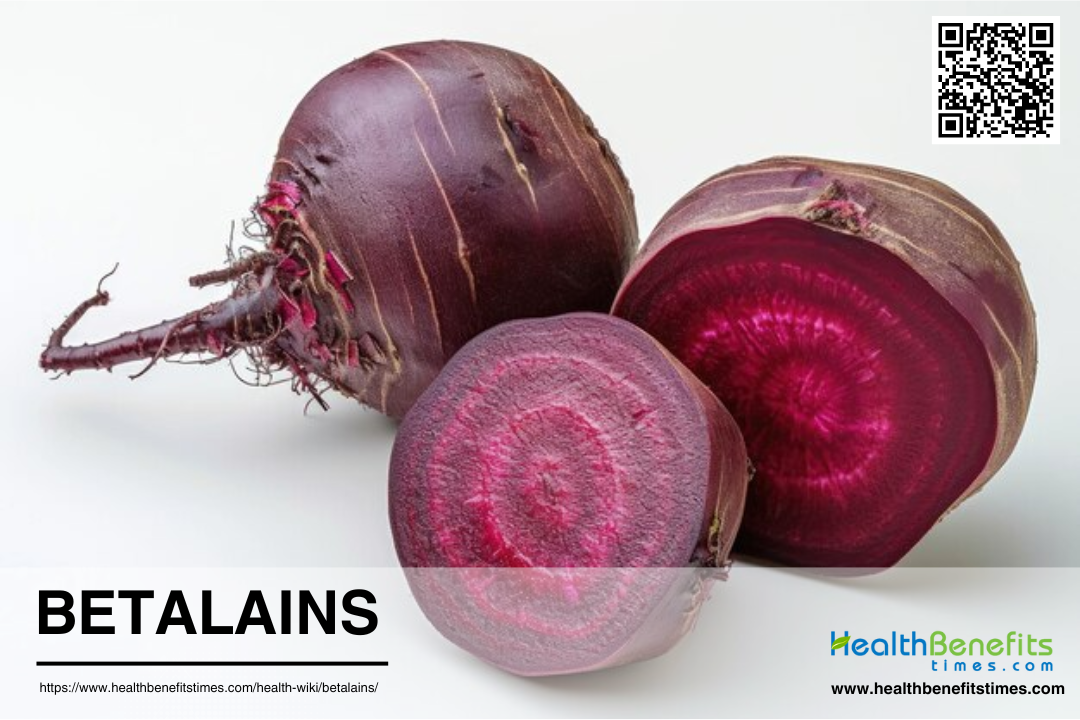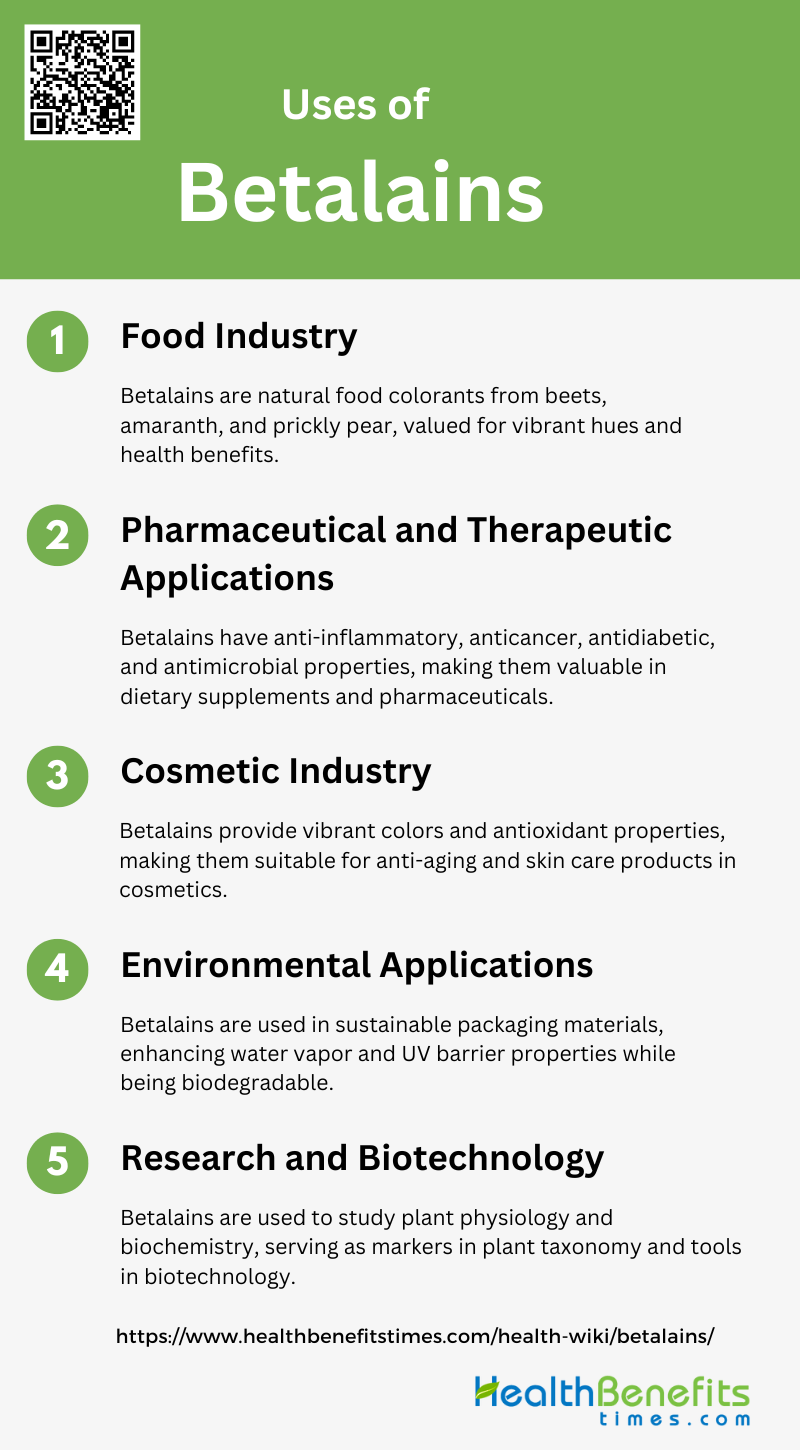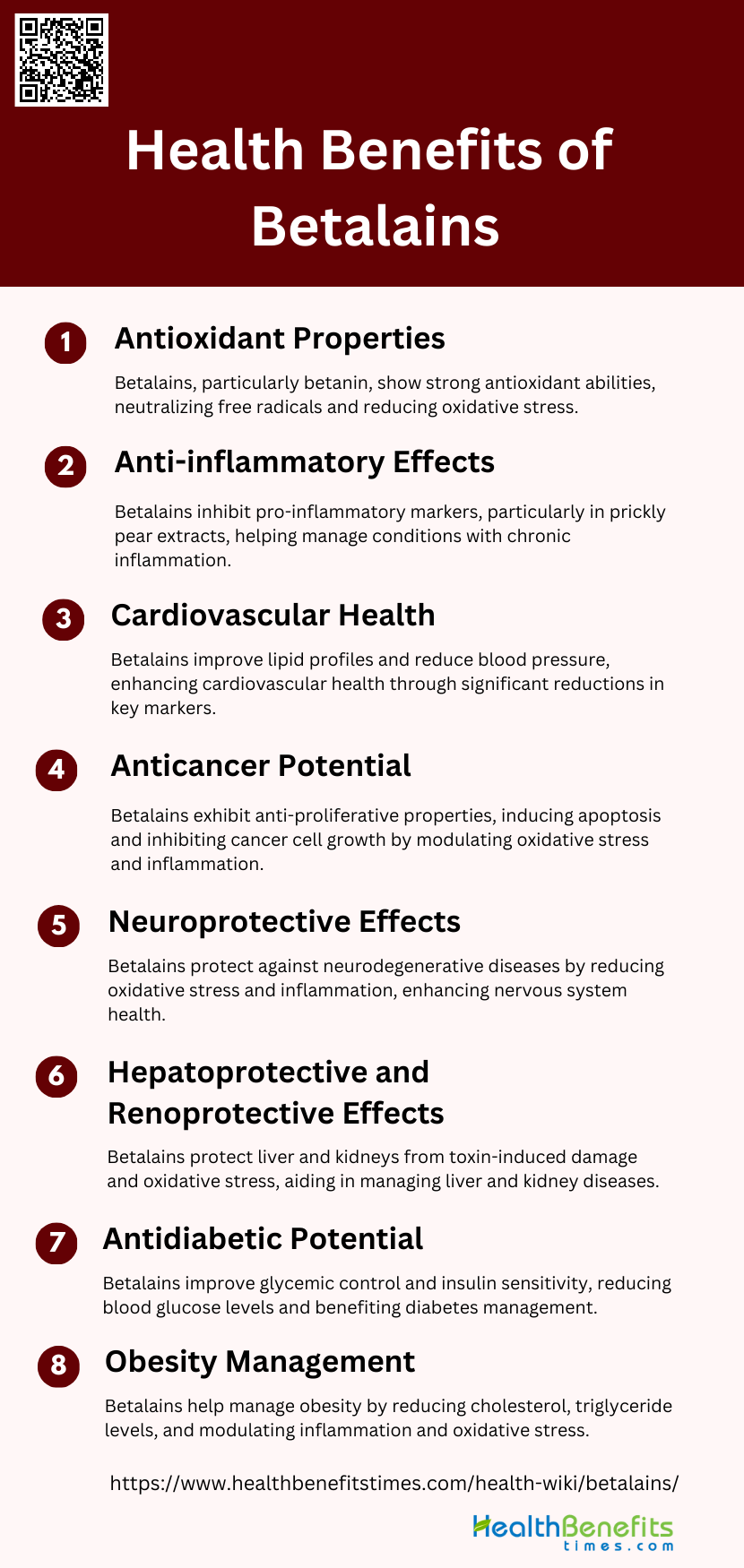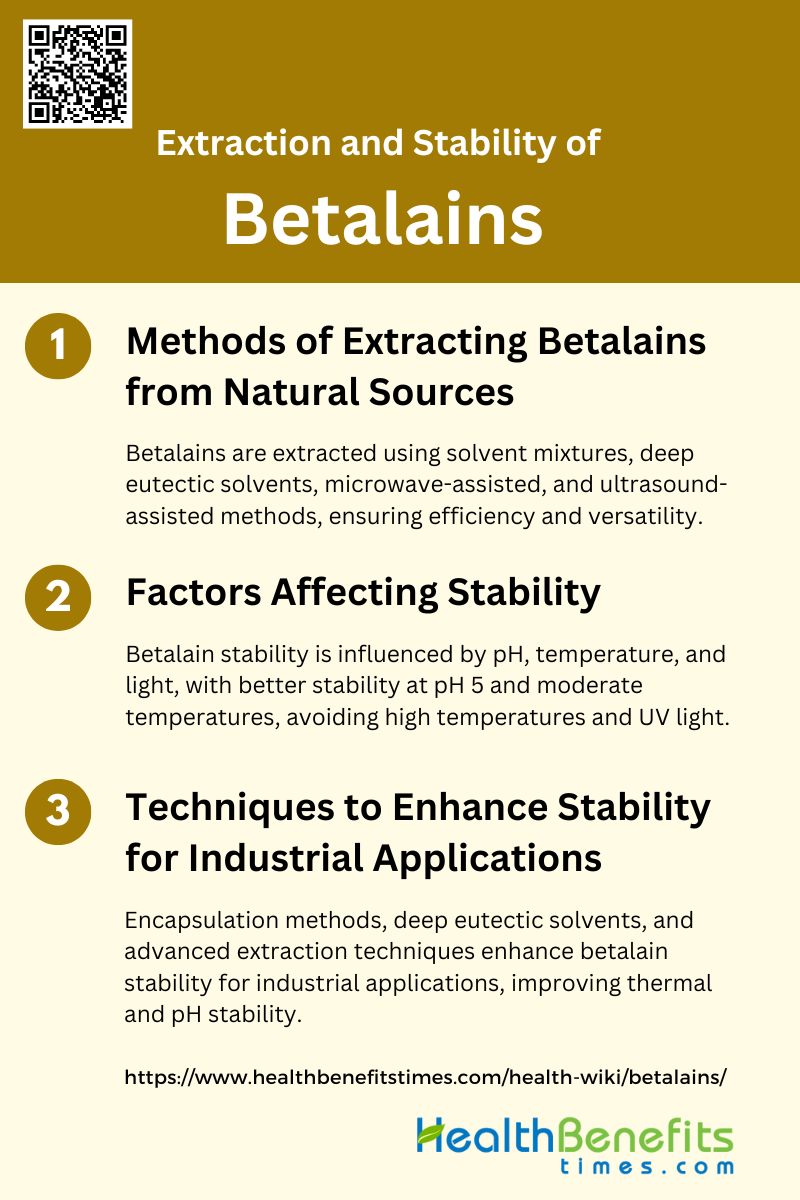Betalains are a class of water-soluble pigments found in plants of the order Caryophyllales, where they replace anthocyanin pigments. They are divided into two main categories: betacyanins, which produce red-violet colors, and betaxanthins, which produce yellow-orange colors. Betalains are derived from the amino acid tyrosine and are structurally and chemically distinct from anthocyanins. The most well-known source of betalains is the red beetroot (Beta vulgaris), but they are also found in other plants such as amaranth, prickly pear cactus, and pitaya. Betalains have gained interest in the food industry as natural colorants and are also being studied for their potential health benefits due to their antioxidant properties.
Types of Betalains
Betalains are a class of red and yellow indole-derived pigments found in plants. They are categorized into two main types based on their color and chemical structure. Here are the different types of betalains:
1. Betacyanins
Betacyanins are a class of betalain pigments known for their vibrant red to violet hues. These pigments are primarily found in plants of the Amaranthaceae family and are notable for their strong antioxidant properties. Studies have shown that betacyanins, such as gomphrenin types, exhibit significant free radical scavenging activity, with EC(50) values as low as 3.7 microM, which is 3-4 times stronger than ascorbic acid and other common antioxidants like rutin and catechin. The antioxidant activity of betacyanins is influenced by their chemical structure, particularly the number and position of hydroxyl groups and glycosylation of aglycones. This makes them highly effective in neutralizing free radicals and potentially beneficial in reducing oxidative stress in biological systems.
2. Betaxanthins
Betaxanthins are another class of betalain pigments, characterized by their yellow to orange coloration. These pigments also exhibit strong antioxidant properties, although generally slightly less potent than betacyanins. For instance, dopamine-betaxanthin and (S)-tryptophan-betaxanthin have shown significant free radical scavenging activities, with EC(50) values around 4.2 microM. The antiradical activity of betaxanthins is influenced by the pH of the reaction medium, with higher pH levels enhancing their effectiveness. The structural features of betaxanthins, such as the presence of imino groups, play a crucial role in their ability to donate electrons and stabilize free radicals, making them valuable for their potential health benefits in combating oxidative stress.
Uses of Betalains
They are known for their vibrant red and yellow colors and have applications in food coloring, cosmetics, and health supplements. Here are some common uses of betalains:
1. Food Industry
Betalains are increasingly popular as natural colorants in the food industry due to their vibrant hues and health benefits. These pigments, derived from sources like red beetroot, amaranth, and prickly pear, offer an appealing alternative to synthetic dyes, which have raised health concerns among consumers. Betalains not only enhance the aesthetic value of food products but also contribute to their nutritional profile by providing antioxidant, anti-cancer, and antimicrobial properties. Their stability and safety make them suitable for various food applications, including functional foods and intelligent packaging that monitors food freshness.
2. Pharmaceutical and Therapeutic Applications
Betalains exhibit a range of pharmacological properties that make them valuable in pharmaceutical and therapeutic applications. These pigments have demonstrated anti-inflammatory, anticancer, antidiabetic, and antimicrobial effects, making them promising candidates for dietary supplements and pharmaceutical agents. For instance, betalain-rich extracts from Amaranthus spinosus have shown significant antimalarial activity, while other studies have highlighted their potential in managing oxidative stress, inflammation, and dyslipidemia-related diseases. The non-toxic nature and health-promoting properties of betalains further enhance their appeal in therapeutic contexts.
3. Cosmetic Industry
In the cosmetic industry, betalains are valued for their vibrant colors and skin-beneficial properties. These natural pigments are used in various cosmetic formulations to provide color and enhance the visual appeal of products. Additionally, betalains possess antioxidant properties that can protect the skin from oxidative damage, making them suitable for anti-aging and skin care products. Their ability to act as functional ingredients and health enhancers makes them a promising alternative to synthetic colorants, aligning with the growing consumer demand for natural and safe cosmetic products.
4. Environmental Applications
Betalains also have potential environmental applications, particularly in the development of sustainable and biodegradable materials. For example, betalain-rich extracts have been incorporated into starch/polyvinyl alcohol films to create active and intelligent packaging that can monitor food freshness and reduce waste. These films exhibit enhanced water vapor and ultraviolet light barrier properties, as well as antioxidant and antimicrobial potential, making them suitable for eco-friendly packaging solutions. The biodegradability and non-toxic nature of betalains further support their use in environmentally friendly applications.
5. Research and Biotechnology
In research and biotechnology, betalains serve as valuable tools for studying plant physiology, biochemistry, and genetics. These pigments are used as chemosystematic markers to understand plant taxonomy and evolution within the Caryophyllales order. Additionally, the biosynthesis and stability of betalains are subjects of extensive research, with studies focusing on optimizing their production and extraction for commercial use. The unique properties of betalains, such as their fluorescence and spectroscopic characteristics, also make them useful in various biotechnological applications, including the development of biosensors and diagnostic tools.
Health Benefits of Betalains
These compounds can help protect cells from damage, reduce inflammation, and support overall wellness. Here are some key health benefits of betalains:
1. Antioxidant Properties
Betalains, particularly betanin, exhibit significant antioxidant properties. These pigments, found in plants like red beetroot, have been shown to possess high radical scavenging abilities. For instance, betalain extracts from hairy root cultures of red beetroot demonstrated a six-fold higher 2, 2-diphenyl-1-picrylhydrazyl (DPPH) radical scavenging ability compared to extracts from mature beetroots, indicating their potent antioxidant activity. This antioxidant capacity is attributed to the high concentration of phenolic compounds in betalains, which work synergistically to neutralize free radicals and reduce oxidative stress.
2. Anti-inflammatory Effects
Studies have shown that betalain-rich extracts can significantly inhibit the release of pro-inflammatory markers such as IL-6, IL-8, and nitric oxide (NO) in various in vitro models. These effects are particularly pronounced in extracts from prickly pear, which demonstrated superior anti-inflammatory activity compared to pure betalains like betanin and indicaxanthin. The anti-inflammatory properties of betalains make them promising candidates for managing conditions characterized by chronic inflammation.
3. Cardiovascular Health
In a study involving patients with atherosclerotic cardiovascular disease, supplementation with betalain-rich extracts led to significant reductions in homocysteine, glucose, total cholesterol, triglycerides, and LDL levels. Additionally, both systolic and diastolic blood pressures were lowered, suggesting that betalains can be considered functional foods for cardiovascular health improvement.
4. Anticancer Potential
The anticancer potential of betalains is supported by various preclinical studies. Betanin, a prominent betalain, has been shown to possess anti-proliferative and anticancer properties, making it effective against different cancer cell lines. These pigments induce apoptosis and inhibit the growth of cancer cells, highlighting their potential as natural anticancer agents. The ability of betalains to modulate oxidative stress and inflammation further contributes to their anticancer effects.
5. Neuroprotective Effects
Betalains also exhibit neuroprotective effects, which are crucial for preventing neurodegenerative diseases. These pigments protect the nervous system from oxidative stress and inflammation, which are common contributors to conditions like Alzheimer’s disease. The neuroprotective properties of betalains are linked to their antioxidant activity and ability to modulate inflammatory pathways, making them potential therapeutic agents for neuroprotection.
6. Hepatoprotective and Renoprotective Effects
These pigments help protect the liver and kidneys from damage induced by toxins and oxidative stress. For instance, betaine, a compound related to betalains, has been shown to prevent alcohol-induced hepatic steatosis and progressive liver injury by regulating methionine metabolism and reducing oxidative stress. Similarly, betalains have been found to exhibit protective effects against kidney damage, highlighting their potential in managing liver and kidney diseases.
7. Antidiabetic Potential
Studies have confirmed that betalains can reduce glycemia by up to 40% without causing weight loss or liver impairment. These effects are attributed to the ability of betalains to enhance insulin sensitivity and modulate glucose metabolism, making them beneficial for managing diabetes and related metabolic disorders.
8. Obesity Management
These pigments have been shown to exert lipid-lowering effects, reducing total cholesterol and triglyceride levels. Additionally, betalains help in modulating inflammatory pathways and oxidative stress, which are often elevated in obesity. The therapeutic potential of betalains in obesity management is supported by their ability to improve metabolic health and reduce the risk of obesity-related complications.
Betalains in Your Diet
Incorporating betalains into your diet can offer numerous health benefits due to their antioxidant, anti-inflammatory, and detoxifying properties. These natural pigments, found in foods like beets, Swiss chard, and prickly pear, not only add vibrant colors to your meals but also support overall wellness. Here are some ways to include betalains in your diet:
- Add beetroot to salads, smoothies, or juices.
- Use Swiss chard as a leafy green in your dishes.
- Try prickly pear fruit in desserts or as a snack.
- Incorporate beetroot powder into baked goods or soups.
- Experiment with beet-based dips like beet hummus.
Supplement options for betalains
Betalains can be found in various supplement forms to help you incorporate their health benefits into your daily routine. Here are some common options:
- Beetroot Powder: This is a popular supplement that can be easily added to smoothies, juices, or even baked goods. It retains the betalains found in fresh beets.
- Beetroot Capsules: For those who prefer a more convenient option, beetroot capsules provide a concentrated dose of betalains without the need for preparation.
- Beetroot Juice: Available in both fresh and powdered forms, beetroot juice is another way to consume betalains. It can be drunk on its own or mixed with other juices.
- Prickly Pear Extract: This supplement is derived from the prickly pear cactus and is rich in betalains. It is available in capsule or liquid form.
- Swiss chard Supplements: Although less common, some supplements are made from Swiss chard, another betalain-rich vegetable.
Extraction and Stability of Betalains
The extraction and stability of betalains are crucial for their effective use in various applications, including food coloring and health supplements. These natural pigments can be sensitive to factors such as pH, temperature, and light, which can affect their color and potency. Here are some key considerations for the extraction and stability of betalains:
1. Methods of Extracting Betalains from Natural Sources
Traditional solvent extraction methods, such as using methanol/water or ethanol/water mixtures, have been employed effectively. For instance, a study on Opuntia joconostle used a Box-Behnken statistical design to optimize solvent concentration, temperature, and treatment time, achieving a maximum pigment concentration at 15°C and 10 minutes with a methanol/water mixture. Deep eutectic solvents (DES) have also been explored for their efficiency in extracting betalains from beetroot waste, showing comparable results to conventional methods. Microwave-assisted extraction (MAE) has been shown to significantly enhance betalain yield from red beets, with optimal conditions identified for different types of betalains. Ultrasound-assisted extraction is another emerging technique, optimized for extracting betalains from quinoa hulls, demonstrating high efficiency in a short time. These methods highlight the versatility and efficiency of both conventional and modern extraction techniques.
2. Factors Affecting Stability
The stability of betalains is influenced by several environmental factors, including pH, temperature, and light. Betalains are generally more stable at a pH around 5 and moderate temperatures, as demonstrated in the extraction from Opuntia joconostle. High temperatures and extreme pH levels can lead to significant degradation of these pigments. For instance, betalains from beetroot showed better stability when stored at lower temperatures and protected from UV light. Additionally, the presence of oxygen and light exposure can accelerate the degradation process, as seen in the degradation tests of betalains from beetroot waste. The chemical instability of betalains under various conditions necessitates careful control of environmental factors to maintain their stability.
3. Techniques to Enhance Stability for Industrial Applications
To enhance the stability of betalains for industrial applications, several techniques have been developed. Encapsulation methods, such as nanoemulsions, have been shown to improve the thermal and pH stability of betalains significantly. Nanoemulsions prepared from beetroot extract demonstrated higher stability and sustained release compared to microemulsions. The use of deep eutectic solvents (DES) also offers enhanced stability, with betalains from DES extracts maintaining stability for extended periods under light and storage conditions. Additionally, pretreatment methods and advanced extraction techniques, such as ultrasound and microwave-assisted extraction, not only improve extraction yields but also contribute to the stability of the pigments. These advancements in extraction and stabilization techniques are crucial for the effective use of betalains as natural colorants in the food industry.
Regulations and Safety of Betalains
The regulations and safety of betalains, natural pigments found in beets and other plants, are crucial for ensuring their safe use in food and cosmetic products. Various international and national bodies have established guidelines to monitor their quality and application. Below are the key regulations and safety measures associated with betalains:
1. Overview of Guidelines and Regulations for Using Betalains in Food and Cosmetics
Regulatory bodies such as the FDA and EFSA have approved betalains, particularly betanin, for use in food products, recognizing their safety and health benefits. However, their application in cosmetics is less prevalent, primarily due to stability issues under various environmental conditions such as heat, pH, and light. Despite these challenges, ongoing research aims to improve the stability of betalains, which could expand their use in both food and cosmetic industries.
2. Safety Assessments and Studies
Numerous studies have confirmed the safety of betalains, highlighting their antioxidant properties and lack of cytotoxicity. In vitro and in vivo studies have demonstrated that betalains are non-toxic and can be safely consumed at recommended doses. Clinical trials have shown that betalains can improve cardiovascular health by modulating gene expression related to longevity and inflammation. Additionally, betalains have been found to possess radioprotective properties, further supporting their safety and potential health benefits. The antioxidant activity of betalains also contributes to their safety profile, as they help mitigate oxidative stress in the body.
3. Consumer Acceptance and Market Trends
Consumer acceptance of betalains is generally high, driven by the growing demand for natural and health-promoting food additives. Betalains are particularly popular in the functional food market due to their vibrant colors and associated health benefits. Market trends indicate an increasing interest in betalain-rich products, such as beetroot supplements, which are marketed for their antioxidant and anti-inflammatory properties. However, the market penetration of betalains in cosmetics remains limited, primarily due to stability issues. Efforts to enhance the stability of betalains through advanced processing techniques could potentially boost their acceptance and usage in the cosmetic industry.





